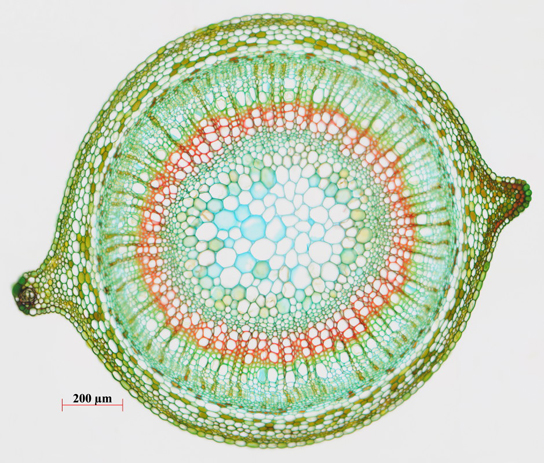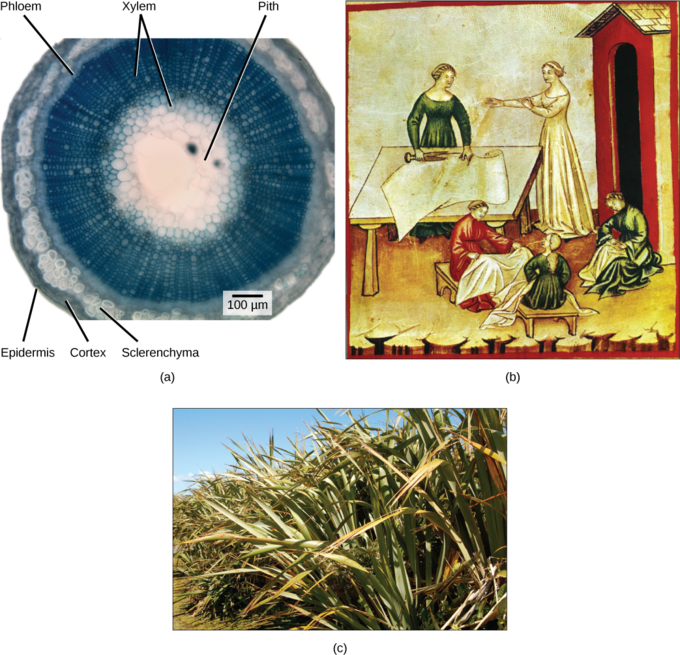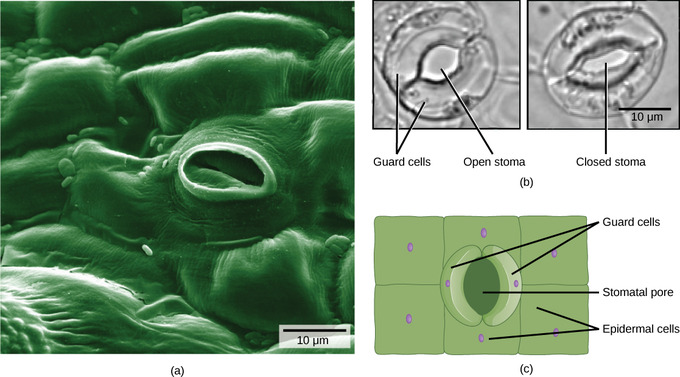30.3: Stems - Stem Anatomy
- Page ID
- 13746
- Summarize the roles of dermal tissue, vascular tissue, and ground tissue
Stem Anatomy
The stem and other plant organs are primarily made from three simple cell types: parenchyma, collenchyma, and sclerenchyma cells. Parenchyma cells are the most common plant cells. They are found in the stem, the root, the inside of the leaf, and the pulp of the fruit. Parenchyma cells are responsible for metabolic functions, such as photosynthesis. They also help repair and heal wounds. In addition, some parenchyma cells store starch.

Collenchyma cells are elongated cells with unevenly-thickened walls. They provide structural support, mainly to the stem and leaves. These cells are alive at maturity and are usually found below the epidermis. The “strings” of a celery stalk are an example of collenchyma cells.

Sclerenchyma cells also provide support to the plant, but unlike collenchyma cells, many of them are dead at maturity. There are two types of sclerenchyma cells: fibers and sclereids. Both types have secondary cell walls that are thickened with deposits of lignin, an organic compound that is a key component of wood. Fibers are long, slender cells; sclereids are smaller-sized. Sclereids give pears their gritty texture. Humans use sclerenchyma fibers to make linen and rope.

As with the rest of the plant, the stem has three tissue systems: dermal, vascular, and ground tissue. Each is distinguished by characteristic cell types that perform specific tasks necessary for the plant’s growth and survival.
Dermal Tissue
The dermal tissue of the stem consists primarily of epidermis: a single layer of cells covering and protecting the underlying tissue. Woody plants have a tough, waterproof outer layer of cork cells commonly known as bark, which further protects the plant from damage. Epidermal cells are the most-numerous and least-differentiated of the cells in the epidermis. The epidermis of a leaf also contains openings, known as stomata, through which the exchange of gases takes place. Two cells, known as guard cells, surround each leaf stoma, controlling its opening and closing and, thus, regulating the uptake of carbon dioxide and the release of oxygen and water vapor. Trichomes are hair-like structures on the epidermal surface. They help to reduce transpiration (the loss of water by aboveground plant parts), increase solar reflectance, and store compounds that defend the leaves against predation by herbivores.

Vascular Tissue
The xylem and phloem that make up the vascular tissue of the stem are arranged in distinct strands called vascular bundles, which run up and down the length of the stem. Both are considered complex plant tissue because they are composed of more than one simple cell type that work in concert with each other. When the stem is viewed in cross section, the vascular bundles of dicot stems are arranged in a ring. In plants with stems that live for more than one year, the individual bundles grow together and produce the characteristic growth rings. In monocot stems, the vascular bundles are randomly scattered throughout the ground tissue.

Xylem tissue has three types of cells: xylem parenchyma, tracheids, and vessel elements. The latter two types conduct water and are dead at maturity. Tracheids are xylem cells with thick secondary cell walls that are lignified. Water moves from one tracheid to another through regions on the side walls known as pits where secondary walls are absent. Vessel elements are xylem cells with thinner walls; they are shorter than tracheids. Each vessel element is connected to the next by means of a perforation plate at the end walls of the element. Water moves through the perforation plates to travel up the plant.
Phloem tissue is composed of sieve-tube cells, companion cells, phloem parenchyma, and phloem fibers. A series of sieve-tube cells (also called sieve-tube elements) are arranged end-to-end to create a long sieve tube, which transports organic substances such as sugars and amino acids. The sugars flow from one sieve-tube cell to the next through perforated sieve plates, which are found at the end junctions between two cells. Although still alive at maturity, the nucleus and other cell components of the sieve-tube cells have disintegrated. Companion cells are found alongside the sieve-tube cells, providing them with metabolic support. The companion cells contain more ribosomes and mitochondria than do the sieve-tube cells, which lack some cellular organelles.
Ground Tissue
Ground tissue is mostly made up of parenchyma cells, but may also contain collenchyma and sclerenchyma cells that help support the stem. The ground tissue towards the interior of the vascular tissue in a stem or root is known as pith, while the layer of tissue between the vascular tissue and the epidermis is known as the cortex.
Key Points
- The stem has three simple cell types: the parenchyma, collenchyma, and sclerenchyma cells that are responsible for metabolic functions, repairing and healing wounds, and storing starch.
- The stem is composed of three tissue systems that include the epidermis, vascular, and ground tissues, all of which are made from the simple cell types..
- The xylem and phloem carry water and nutrients up and down the length of the stem and are arranged in distinct strands called vascular bundles.
- The epidermis is a single layer of cells that makes up the dermal tissue covering the stem and protecting the underlying tissue. Woody plants have an extra layer of protection on top of the epidermis made of cork cells known as bark.
- The vascular tissue of the stem consists of the complex tissues xylem and phloem which carry water and nutrients up and down the length of the stem and are arranged in distinct strands called vascular bundles.
- Ground tissue helps support the stem and is called pith when it is located towards the middle of the stem and called the cortex when it is between the vascular tissue and the epidermis.
Key Terms
- collenchyma: a supporting ground tissue just under the surface of various leaf structures formed before vascular differentiation
- sclerenchyma: a mechanical, supportive ground tissue in plants consisting of aggregates of cells having thick, often mineralized walls
- sclereid: a reduced form of sclerenchyma cells with highly-thickened, lignified walls
- lignin: a complex, non-carbohydrate, aromatic polymer present in all wood
- stoma: a pore found in the leaf and stem epidermis used for gaseous exchange
- trichome: a hair- or scale-like extension of the epidermis of a plant
- xylem: a vascular tissue in land plants primarily responsible for the distribution of water and minerals taken up by the roots; also the primary component of wood
- phloem: a vascular tissue in land plants primarily responsible for the distribution of sugars and nutrients manufactured in the shoot
- tracheid: elongated cells in the xylem of vascular plants that serve in the transport of water and mineral salts
- pith: the soft spongy substance in the center of the stems of many plants and trees
- cortex: the tissue of a stem or root that lies inward from the epidermis, but exterior to the vascular tissue
- parenchyma: the ground tissue making up most of the non-woody parts of a plant


